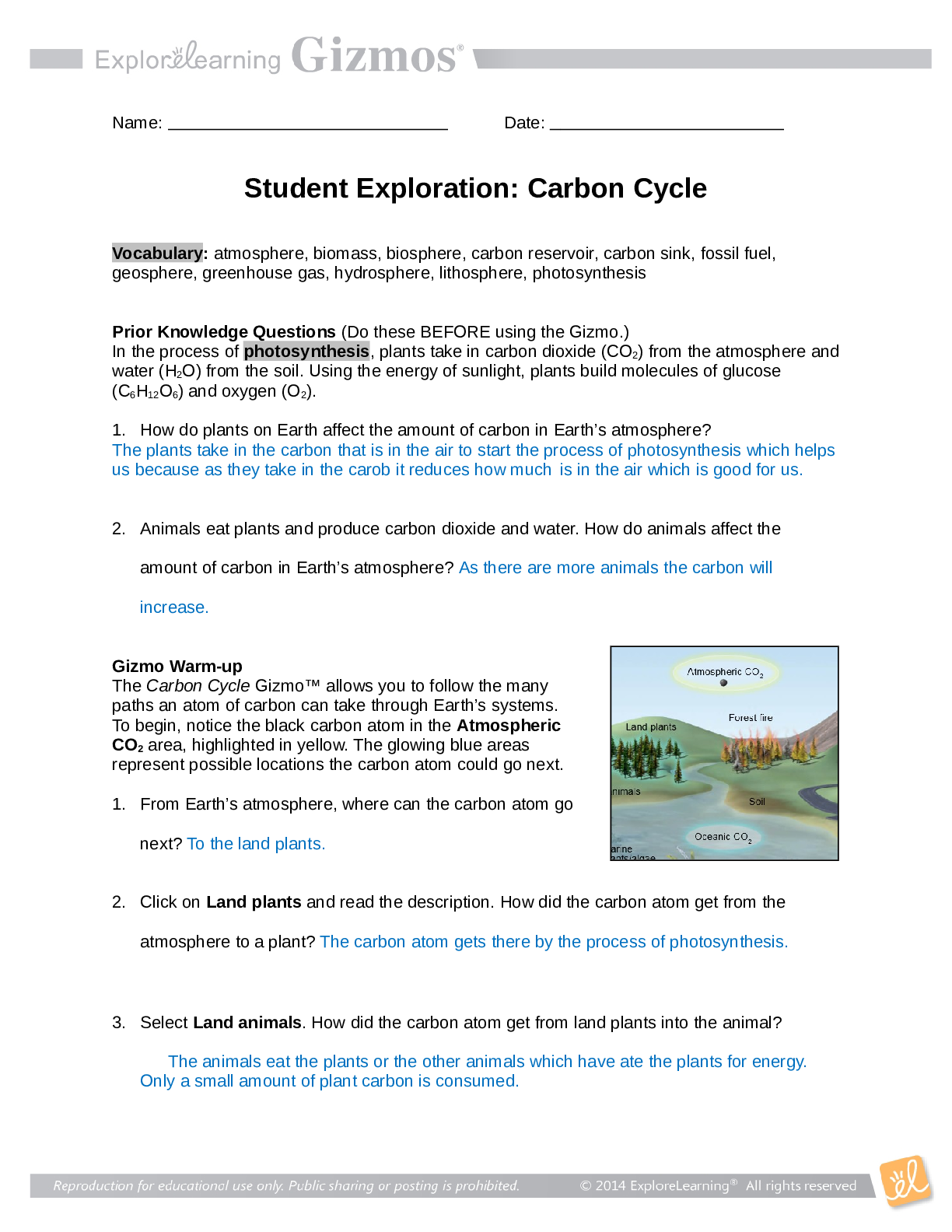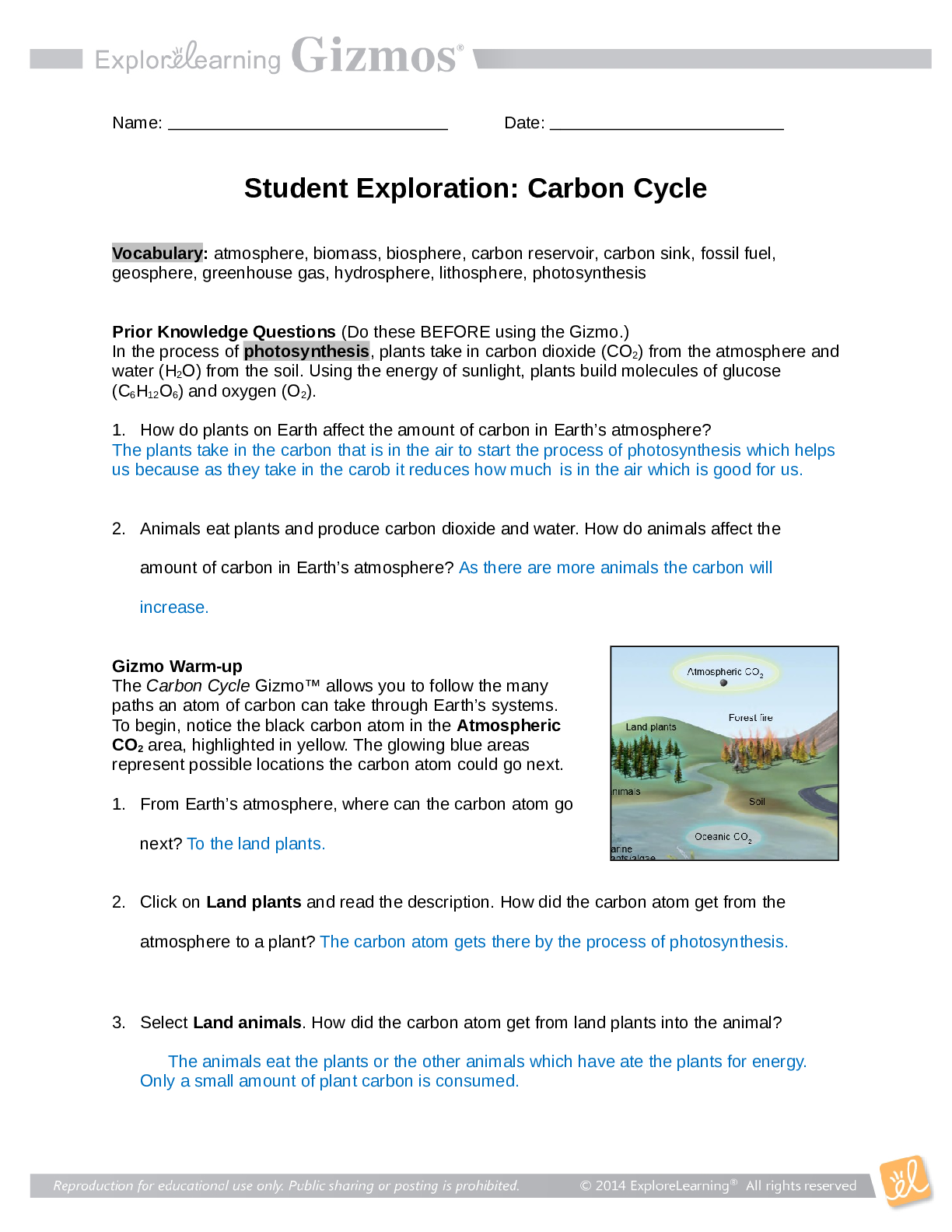Date:
Student Exploration: Carbon Cycle
Vocabulary: atmosphere, biomass, biosphere, carbon reservoir, carbon sink, fossil fuel,
geosphere, greenhouse gas, hydrosphere, lithosphere, photosynthesis
Prior Knowledge Questions (Do these BEFORE using the Gizmo.)
In the process of photosynthesis, plants take in carbon dioxide (CO 2 ) from the atmosphere and
water (H 2 O) from the soil. Using the energy of sunlight, plants build molecules of glucose
(C 6 H 12 O 6 ) and oxygen (O 2 ).
1. How do plants on Earth affect the amount of carbon in Earth’s atmosphere?
The plants take in the carbon that is in the air to start the process of photosynthesis which helps
us because as they take in the carob it reduces how much is in the air which is good for us.
2. Animals eat plants and produce carbon dioxide and water. How do animals affect the
amount of carbon in Earth’s atmosphere? As there are more animals the carbon will
increase.
Gizmo Warm-up
The Carbon Cycle Gizmo™ allows you to follow the many
paths an atom of carbon can take through Earth’s systems.
To begin, notice the black carbon atom in the Atmospheric
CO 2 area, highlighted in yellow. The glowing blue areas
represent possible locations the carbon atom could go next.
1. From Earth’s atmosphere, where can the carbon atom go
next? To the land plants.
2. Click on Land plants and read the description. How did the carbon atom get from the
atmosphere to a plant? The carbon atom gets there by the process of photosynthesis.
3. Select Land animals. How did the carbon atom get from land plants into the animal?
The animals eat the plants or the other animals which have ate the plants for energy.
Only a small amount of plant carbon is consumed.4. Select Atmospheric CO 2 . How did the carbon atom get from land animals back to the
atmosphere? The animal release the carbon back into the air by the process of cellular
respiration.
Activity A:
Get the Gizmo ready:
Click Reset.
Carbon pathways
Introduction: Earth can be divided into four systems. The atmosphere is the air above Earth’s
surface. The hydrosphere is composed of all of Earth’s water. The geosphere is the rocky,
non-living part of Earth. The biosphere consists of all living things, including people. Some
scientists use the term “anthroposphere” to describe everything made or modified by humans.
Question: How does carbon move between the atmosphere, hydrosphere, biosphere, and
geosphere?
1. Explore : Use the Gizmo to create a path for carbon that begins and ends in the atmosphere.
Fill in the steps in the path below. Then, label each location with the system it represents.
Finally, summarize very briefly how the carbon atom got to that location.
Carbon path. System
How it got
there
Atmospheric CO 2. Atmosphere
Land plants Biosphere Atmospheric co2 comes from
volcanoes, burning fossils fuels,
and other sources.
Land plants Biosphere Plants go through photosynthesis.
Land
animals Biosphere Animals eat plants to gain energy.
Soil Geosphere Animals die and remains decay
into the soil.
Sediments Geosphere Soil washed into steams and build
up under water masses.
Atmospheric
CO 2 comes
from
volcanoes,
burning fossil
fuels, and
other sources.Lithosphere Geosphere Sediments get compressed into
sedimentary rocks that are rich in
carbon
Volcano Geosphere Rocks melt underground and
release CO2 which is mixed into
magma.
Atmospheri
c CO2 Atmosphere Volcano erupts putting CO2 back
into the Atmosphere.
2. Create : Click Reset. Use the Gizmo to create a path in which the carbon atom goes from the
atmosphere to the hydrosphere, biosphere and geosphere. Describe each transition briefly.
Atmosphere Hydrosphere Biosphere Geosphere
Atmospheric CO 2 Oceanic CO2 Marine Plants. algae Sediments
Plants and Algae go
through
photosynthesis. Plants and Algae
sink to the bottom of
the ocean building
up large amounts of
carbon.
Volcanoes, burning
fossil fuels, and
other sources.
Cold temperatures
from the ocean
dissolves CO2 and
stores it into deep
waters.
(Activity A continued on next page)Activity A (continued from previous page)
3. Explore : Use the Gizmo to create three more carbon paths, each starting and ending in the
atmosphere. Label each location with A for atmosphere, B for biosphere, G for geosphere,
or H for hydrosphere. (You can also use P for anthroposphere if you like, or just include it in
the biosphere.)
Path 1:
Path 2:
Path 3:
4. Explain : Based on the Gizmo, explain how the following transitions might take place:
A. Describe at least two ways that carbon can get from a land plant to the atmosphere.
B. Describe at least two ways that carbon can get from the atmosphere to the
hydrosphere.
C. Can you find two ways that carbon can get from the ocean to the lithosphere? (The
lithosphere is the rigid layer of the Earth, including the crust and part of the mantle.)D. Describe at least two ways that c
Read More


